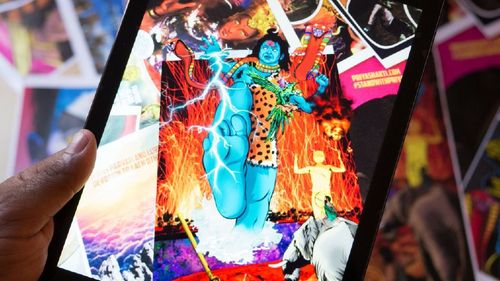The victim had suffered a horrific death. The attackers were unrepentant. The citizens had taken to the streets.
Back in his home town of New Delhi, documentarian Ram Devineni was working on an unrelated project he, and the entire country of India, were suddenly rocked by the news of a brutal gang rape that claimed the life of a local young woman. For a short time, Devineni pondered putting a halt to the film he was working on, and instead turn his lens toward India’s sexual violence crisis.
At one of the protests, Devineni approached a policeman watching over the growing mob. “I asked him what he thought about it all—the girl, the rapists, the protestors,” Devineni told Paste during a recent phone interview. “The policeman said something that has stuck with me ever since: ‘No good girl walks home alone at night.’ Implying she either deserved it, or provoked the rape. And that got me thinking that the problem of sexual violence in India and other cultures is a cultural problem, not a legal issue.”
Devineni also began to think that a documentary would be the wrong medium for telling a story about this deep-seeded issue. Instead, he swapped his camera and tripod for pages of panels and dialogue bubbles. The documentarian decided to create the story of Priya, an Indian rape survivor who teams with Hindu Gods to seek justice. The project has proven to be an international breakthrough, with over 250 news outlets rushing to book interviews with Devineni about the unique project.
He enlisted comic book artist Dan Goldman to sketch the project, featuring lush drawings of the Hindu Gods and striking animals. He then recruited a cutting edge tech team to lace the book’s panels with‘augmented reality’ coding, allowing viewers to scan the pages with their cell phones and see video interviews with the rape survivors that Devineni conducted while researching the story.
Devieni chatted with Paste more about how these elements have helped Priya’s Shakti address such an important issue using an unconventional medium.
![]()
Paste: Ram, before working on Priya’s Shakti you were best known as a documentary filmmaker. Why did you forgo that medium and embrace comic books this time? Why not make a documentary about sexual violence in India?
Ram Devineni: Like a lot of people in India at [that time], I found it to be a very sensitive time. And a lot of us were angry by the lack of response in the government, and also what other politicians were saying about the victim. Because the cop was not the only one saying that. I was thinking about how to approach this with a documentary, and I realised that the topic was way too hot, and that I would not be able to do it properly. I’m not a journalist, I’m a filmmaker. So I have to tell a story. And I felt that I couldn’t tell a story in the documentary format.
Paste: Why would a “too hot” issue deter you as a filmmaker? Wouldn’t that make for the most enticing documentary material?
Devineni: A lot of documentarians are right in the middle of their films, close to the protagonist and the character’s experience and struggles. But I didn’t have access to that, I wasn’t able to reach any of the people directly affected by the bus rape at that time. For that reason, I thought I couldn’t do a proper job. It would have been just reportage, like a news story, which I didn’t want to do. I think the best documentaries have a mix of that and reflection, and go deeper into the problem and the issue.
But I knew that I wanted to cover in some way. So I started researching, talking to NGO’s and eventually rape survivors. I got their stories and found out that sexual violence problems are deeply rooted in culture. A lot of the rape survivors told me that they couldn’t get justice—not because of legal issues, but because their families and friends discouraged it. They thought the stigma of rape was put on them. I spoke with one rape survivor in northern India, and she told me the rapists videotaped the attack on their phones, and threatened that if she ever tried to seek justice they would release the video and show it to her family. So she lived with that stigma and silence until that same group of men raped another woman in another village. And it was only then that she went through the legal process.
Paste: Did she have any success in the courts?
Devineni: Yes, she found justice. But I interviewed her three years after that verdict, and when we met there was a police officer with a semi automatic machine gun guarding her. Whenever she went back to her town, she had to have protection because there were death threats. For her, the fear of death was constant. She was 19 when I interviewed her, and I started thinking: ‘What 19-year-old girl would seek justice, knowing this is what the future holds for her?’ So if there’s no cultural support for rape survivors, they’re never going to go public. And this creates a vicious circle among more men to commit rape, because they know that they can get away with it.
The rapes that happened in Mumbai were done by men who felt impervious to the law. They thought they’d never get caught, because they thought these women would never go public.
Paste: How did this research and interviewing lead to you writing a graphic novel?
Devineni: I travelled extensively through India for this research, and all that time there got me thinking about my childhood. As a kid there, I remember reading these mythological comic books that were hugely popular back in the ‘70s and ‘80s. They were read by every kid. It was the way I learned about Hinduism. I remember thinking that the common motif in these comics was that a villager would call upon the Gods for help, especially in dire situations. And, after talking to the rape survivors, I thought: “What’s more of a dire situation than what’s happening in India now?”
So I met up with Dan Goldman, who’s the artist for the comic. And we had many discussions about how to approach this. He contributed so much.
Paste: Tell me more about your collaboration with Dan.
Devineni: Dan’s great at mixing realism and comic book art. That was especially important for this story, it was about a real issue, with a fictional character based on real victims. I love the idea of mixing the real issue with comic book art, because the reader won’t feel removed or distant from it. And adding the Hindu mythology to it, to an extent, is kind of otherworldly. So by mixing the realism and comic book art, it made the Hindu Gods more down to earth.
Paste: Why did you want to make the Gods more down to earth?
Devineni: I wanted the Gods to contend with a contemporary problem. Eventually in the story it’s up to Priya, the rape survivor to motivate and challenge people. The Gods get involved, but she’s the real agent of change in the story. After being raped she runs into the jungle, because her community throws her out. And she has to confront this tiger, who is the representation of fear, who is stalking her. By facing him and saying a special mantra, she turns the tiger from an enemy into a friend. She then rides the tiger back into the community that threw her out. And she starts motivating people and changing their attitudes about sexual violence.
I’m reappropriating some very common images in Hindu mythology in the book. Having Priya ride a tiger is like the Durga riding the tiger—a famous motif that everyone in India knows. It’s the idea of turning a tiger from a source of fear to strength. This idea, everyone in India totally gets it. And if you don’t know Hinduism or didn’t grow up with these images, it still works very well because we didn’t really try to emphasise religion. It’s more about the metaphors.
Paste: Aside from those traditional elements, Priya’s Shakti also features some futuristic digital visuals.
Devineni: Yes, one of the really cool things about this comic book, aside from its activism, is that you can scan the comic’s pages with your cell phone. When you do that, animated cartoon visuals pop up from the panels, and videos of the interviews with the rape survivors can also be viewed. It’s kind of like a traditional pop-up book, but it uses an “augmented reality” app from a company called Blippar. This is the first major implementation of this technology in India. We’ve incorporated this Blippar technology into Priya’s Shakti street art murals in New Delhi and Mumbai, and we’ll do it again at this exhibition about the comic at the City Lore gallery in New York. That means you can scan the exhibit works in New York, and the street art in those Indian cities, and animation pops out of the wall on your cell phone screen.
Paste: Why did you want to use “augmented reality” to the comic’s pages? How does it further the story?
Devineni: I think it adds a different level of interactive storytelling, especially when you scan some of the pages that let you see the interviews with the rape survivors. It helps you get deeper into the issues. I wanted to show readers that there’s so much that you can experience and imbed into print and digital comic books with “augmented reality.” And the young demographic that we targeted with the comic book is incredibly comfortable with apps and smart phones and devices. It’s like a second home for them, so this scanned content really works well with this audience.
Paste: In other interviews you’ve not only talked about engaging that young audience, but also educating many of them officially by partnering with India’s school system. Have you begun that process yet?
Devineni: Yes, we’re looking at implementing Priya’s Shakti into schools in September. First, we’ll do a test run in the New Delhi school system, that’s in the process of development now. We’ll have to take it slow and see how it goes, though, because doing anything in the school system is really complicated.
Paste: Why?
Devineni: Working with schools in India means going through a lot of administrative levels and red tape. You have to make the right connections, and find the administrators that are enthusiastic about implementing this. This comic also depict Gods, and India is a very secular country, especially in the school system. So we have to work carefully in regard to that. The comic book doesn’t preach or go into Hinduism at all, it’s really more about the mythological stories. So hopefully we can work within that context in the schools.
Paste: How have the rape survivors that you interviewed responded to to the success of the comic, and the idea of students studying their circumstances in school?
Devineni: The response has been overwhelming positive, from both the survivors and general readers. I haven’t gotten any attacks about the comic book. There has been some criticism about not going further, especially about the idea of justice and things like that. But I didn’t want to get into the legal quandaries. I wanted to focus on the bigger story.
Paste: Why not touch on the legal quandaries?
Devineni: Since many of these recent high profile rape cases, India’s supreme court has made a ton of recommendations about how to overhaul the system and make legal changes. Here’s the problem: you can pass as many laws as you want, or implement the fast courts or whatever else, but if the rape survivors don’t feel comfortable, and they don’t have the societal support to seek justice and use those instruments that are given to them, then it’s totally useless. All these laws are useless if the rape survivors don’t feel comfortable pursuing justice. So our goal is to make a societal shift.
The digital Priya’s Shakti comic can be downloaded at www.priyashakti.com. An art exhibit dedicated to the comic will be held at New York’s City Lore gallery in May.





